Galapagos penguins are endemic to the Galapagos Islands.
Most penguin species choose to live in colder, more frigid areas. But one of many Galapagos penguin facts is that these flightless birds do not. Galapagos penguins live along the Equator to the west of Ecuador in South America. They are strong swimmers and have adapted to survive in warmer climates. So, let’s take a deeper plunge into the oceans around the Galapagos islands to explore 10 fun facts about Galapagos penguins.
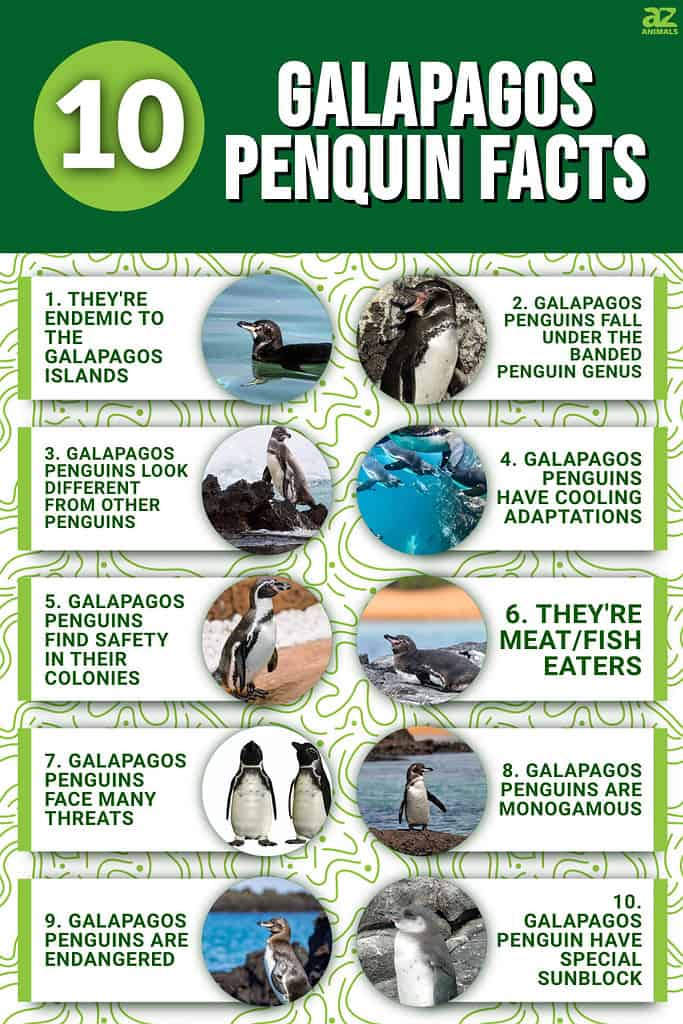
1. They’re Endemic to the Galapagos Islands
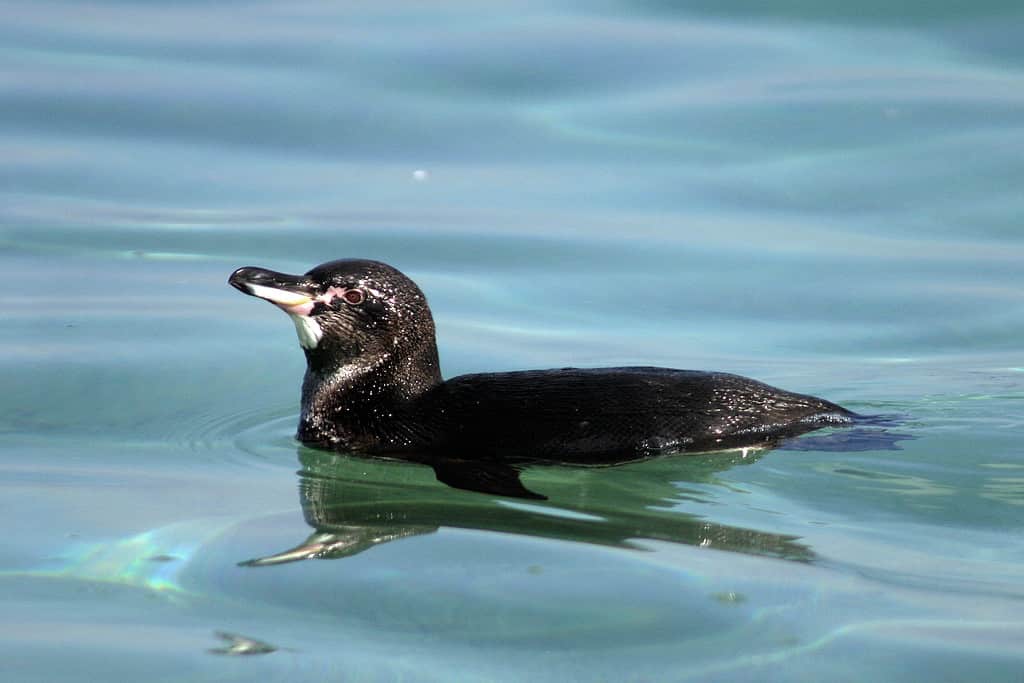
Galapagos penguins are endemic to the Galapagos Islands.
© Charles J. Sharp/CC BY-SA 3.0 – License
The islands, which have given the penguins their name, are located west of Ecuador in South America. The Galapagos penguins are the only species north of the Equator because most penguin species prefer living in colder temperatures. However, one of the 10 fun facts about Galapagos penguins is that they are endemic to the island. They live on rocky beaches along the coast, which meet the Cromwell Current and the Humboldt Current. These currents provide a food supply all year long.
2. Galapagos Penguins Fall Under the Banded Penguin Genus
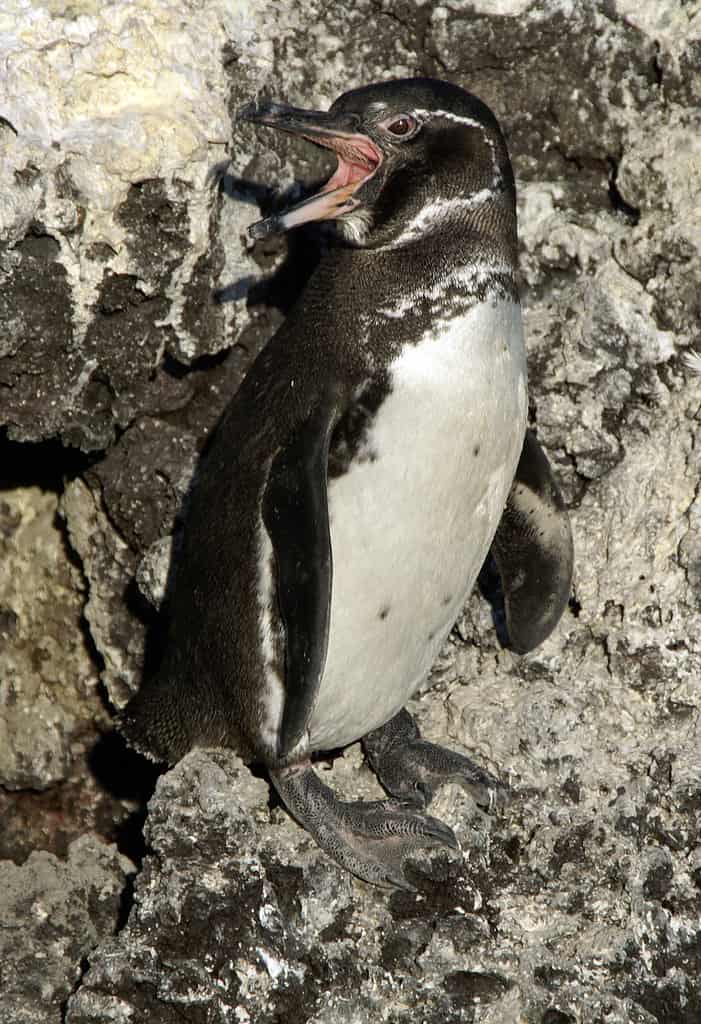
The Galapagos penguin is a species of banded penguin.
©putneymark, CC BY-SA 2.0 – License
This genus consists of four living species of banded penguins. Besides the Galapagos penguin, the other three are the Magellanic, Humboldt, and the African penguin. These penguins all fall under this genius because of the striped markings around their face and body.
3. Galapagos Penguins Look Different From Other Penguins
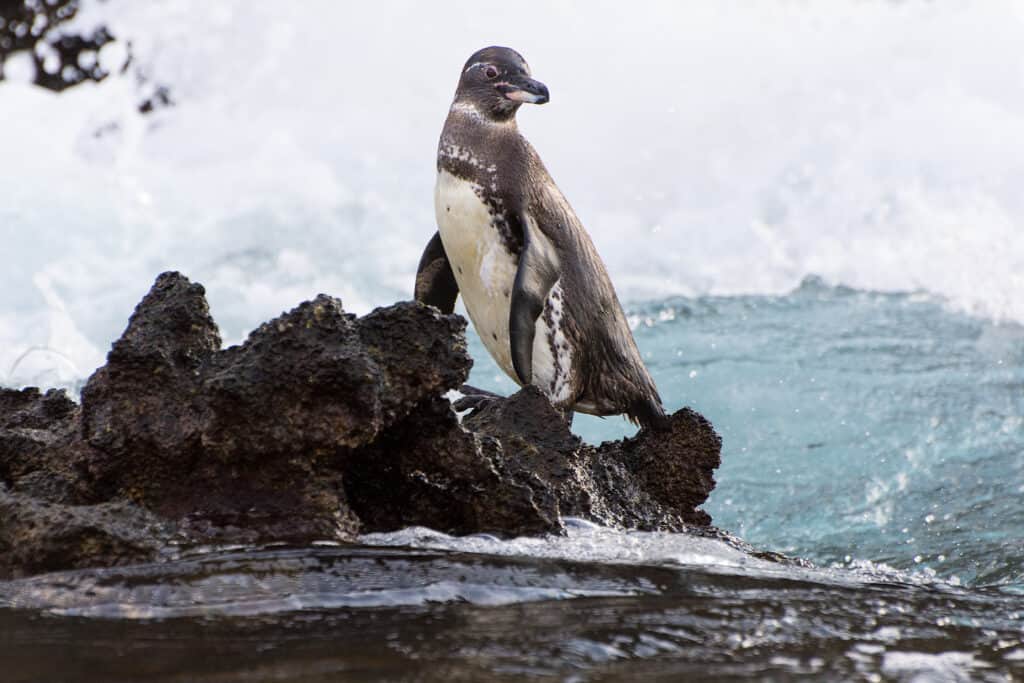
Galapagos penguin (
spheniscus mendiculus) standing on the rocky shore in the Galapagos Islands.
©iStock.com/Kirk Hewlett
The Galapagos penguin is a penguin with a typical black body, white belly, and short wings, just like all other penguin species. But they possess specific physical differences, including a curved stripe of white feathers next to their head and breasts. They also have red eyes and white and pink patches along their lower bill and throat area. These penguins are roughly 20 inches tall and weigh between four and six pounds. This size is small for penguins, making the Galapagos penguin the second smallest penguin species in the world. Another Galapagos penguin fact is that the males and females look very similar. Still, the males are generally bigger than the females.
4. Facts About Galapagos Penguins: Cooling Adaptations
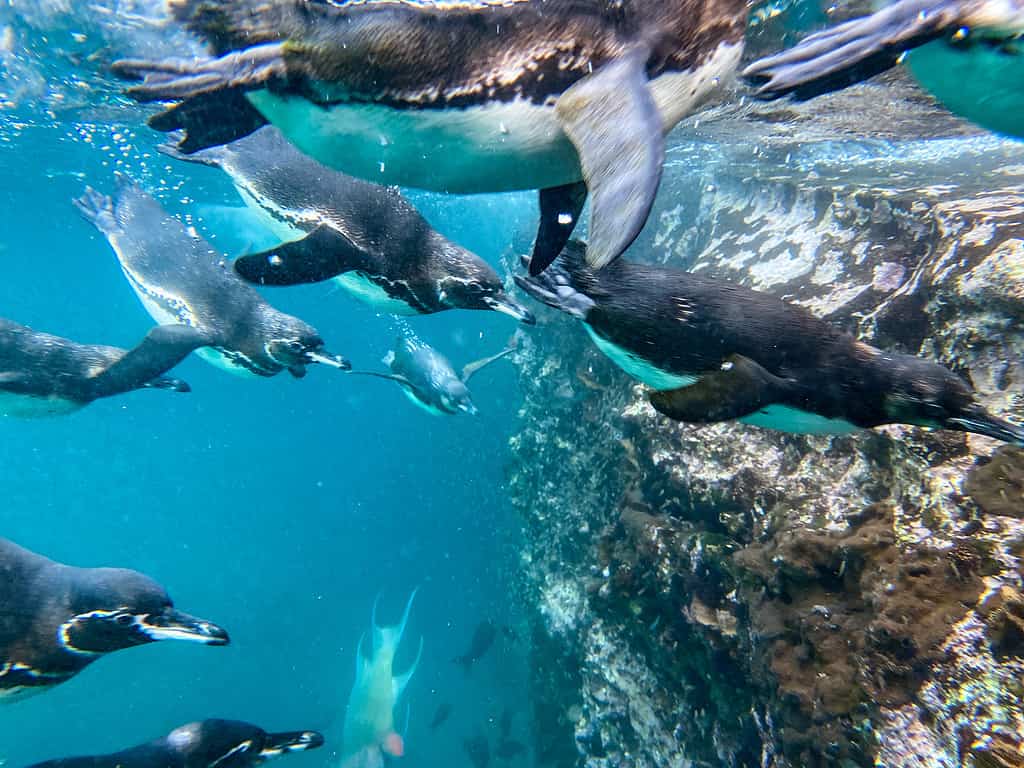
These penguins have also developed wings to help them glide through the water effortlessly.
©Joanne Wastchak/ via Getty Images
Galapagos penguins spend a lot of time in the water, where they hunt and bathe. Their red eyes have evolved to refract light in the water, and their ears have specialized organs that protect them from pressure changes. They have also developed wings to help them glide through the water effortlessly. Additionally, these penguins have adapted to survive in the warmer temperatures of the Galapagos Islands waters.
Other penguins mostly live in colder temperatures, while this penguin lives in a much warmer climate. To cool down in warmer temperatures, this penguin spends a lot of time in the water, another cool fact about this bird. They also spread out their flippers for relief from the sun’s heat. Another fun Galapagos penguin fact is that they also have a featherless patch on their faces for additional relief from the warmer temperatures. And if all else fails, these penguins will pant to cool off.
5. Galapagos Penguins Find Safety in Their Colonies

Galapagos penguins can communicate with other penguins in their territory through vocalizations and body movements.
©iStock.com/mrtekmekci
Galapagos Penguins are social animals and thrive on the colony lifestyle. The colony also provides safety from predators and is known as a noisy space that is constantly moving. Colony members also have access to hunting partners, making it easier to find food. Moreover, another fascinating Galapagos penguin fact is that they can communicate with other penguins in their territory through vocalizations and body movements. These penguins use these vocalizations to maintain group cohesion in the colony and on the hunt. Although the Galapagos penguins live in colonies, they are territorial and fiercely defend their nests.
6. They’re Meat/Fish Eaters
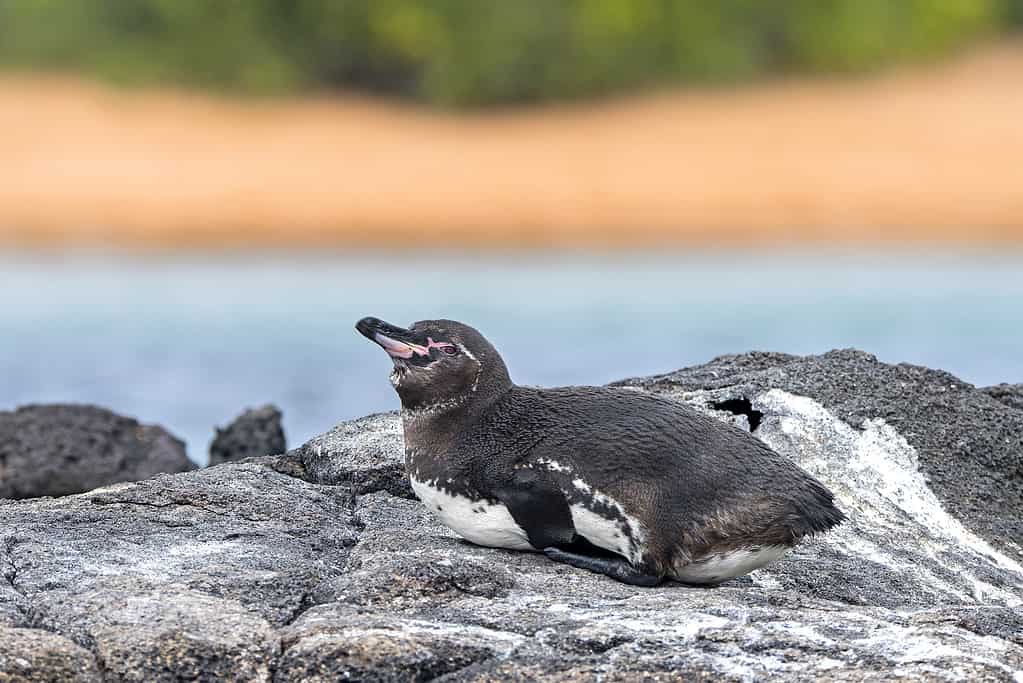
Their excellent eyesight and a strong sense of smell support their hunting abilities.
©/1309102624 via Getty Images
Most Galapagos penguins’ diet consists of smallish sea animals like sardines, anchovies, mullets, and invertebrates. Most sea animals are smaller than an inch, so the penguin colonies work in teams to corner and capture their prey. Their excellent eyesight and a strong sense of smell support their hunting abilities. But the El Niño cycle is possibly responsible for dwindling food sources for the Galapagos penguins, which is unfortunate. The El Niño cycle results in warm phases in the movement of ocean water throughout the Pacific Ocean. Nutrients rise to the ocean’s surface, and fish populations decline when this cycle is in effect. If too many nutrients are swirling around the ocean’s top layer, the penguins may not breed and can even starve to death.
7. Galapagos Penguins Face Many Threats
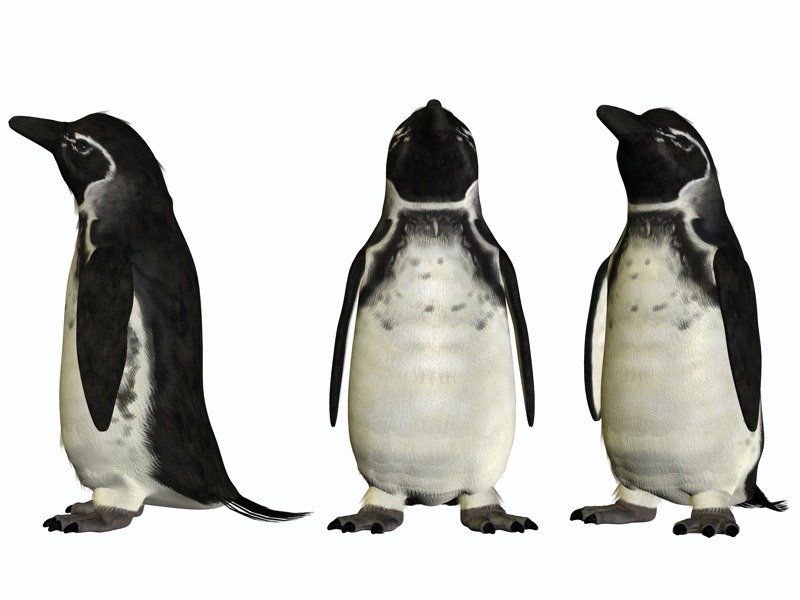
Galapagos penguins are monogamous and mate for life.
©Andreas Meyer/Shutterstock.com
Although the Galapagos penguins prey on small sea creatures, larger sea creatures, like sharks and Galapagos seals, prey on them. But these penguins can camouflage themselves. When viewed from above, the black upper side of the penguin blends in with the darker water below. When viewed from below, the white underside of the penguin blends in with the light from above. And even if they cannot camouflage themselves, these penguins are fast, agile swimmers that can quickly escape predators.
But these birds are often not as lucky on land. The Galapagos hawk often swoops down to kill a penguin before it can get to the safety of the ocean. Other threats, like dogs, cats, rats, and other large birds, introduced to the islands by people, also pose a threat. These animals prey on the penguins but can also transmit diseases in the colonies, a sad fact.
8. Galapagos Penguins Are Monogamous
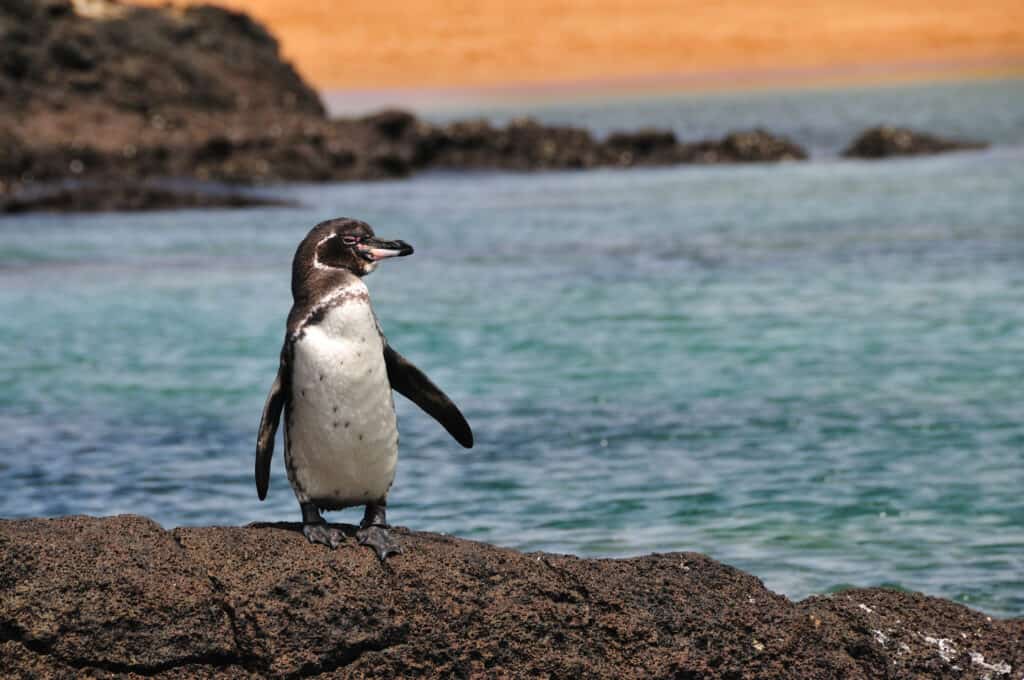
©iStock.com/jmmf
Pairs of these penguins mate for life after courtship rituals, making this one of the cutest Galapagos penguin facts. These courtship rituals consist of preening, bill tapping, and flipper patting. The Galapagos penguins can mate at any time of the year but typically do so when there is an abundant food supply. Once they choose partners, these penguins build a nest for their chicks using rocks and twigs.
These nests provide safety against predators and the sun’s heat. After mating, the female lays two eggs three times a year. These eggs hatch after 38 to 42 days and the happy couple share their parenting duties. Galapagos penguin chicks first have gray, fluffy, downy feathers with white patches on the stomach and cheeks. After two months, these little chicks will fully fledge.
9. Galapagos Penguins Are Endangered
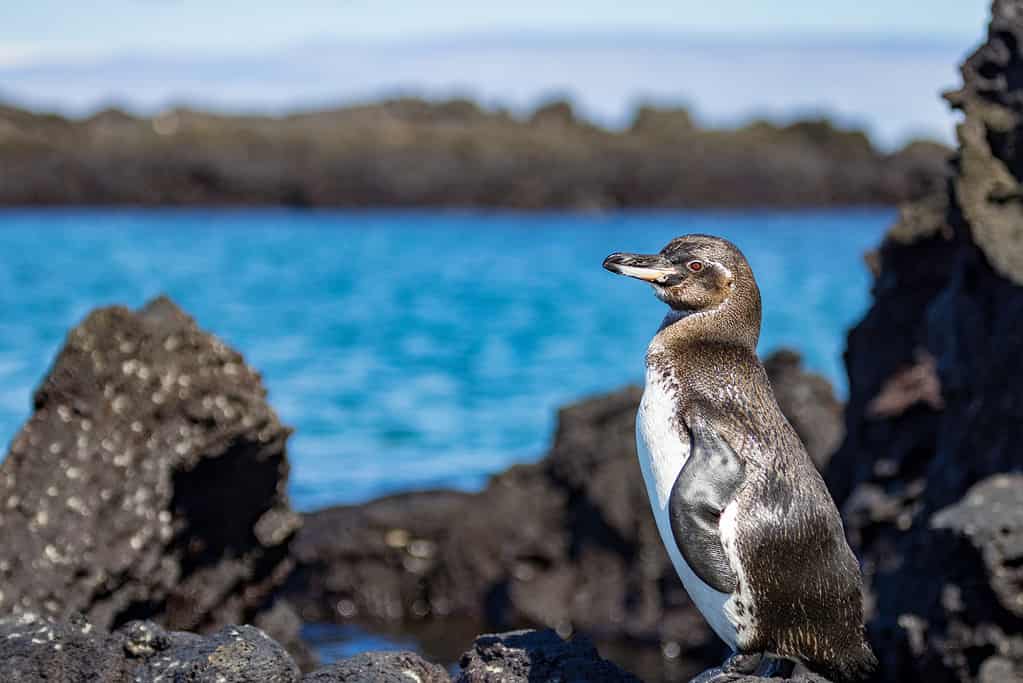
The main reason the Galapagos penguins’ wild population has decreased is climate change.
©Joanne Wastchak/ via Getty Images
The IUCN Red List has listed the Galapagos penguin as an endangered species. There are currently roughly 1,200 Galapagos penguins in the wild, with most living along a small portion of the coast of the island chain. The main reason the Galapagos penguins’ wild population has decreased is climate change.
10. Last of the Galapagos Penguin Facts: Special Sunblock

Galapagos penguins have developed special feathers to protect themselves from the sun.
©Clark Anderson / Aquaimages / CC BY-SA 2.5 – License
The temperatures are warm in the Galapagos Islands, and the sun can be scalding. The chicks have developed special feathers to protect themselves from the sun. These feathers are brown on top and white below, shielding the chicks from sunburn without overheating them.
The photo featured at the top of this post is © iStock.com/jmmf
Sources
- Galápagos Convervancy, Available here: https://www.galapagos.org/projects/saving-species/safeguarding-galapagos-penguins-from-climate-change/
- SeaWorld Parks & Entertainment, Inc., Available here: https://seaworld.org/animals/facts/birds/galapagos-penguin/
- Galapagos Conservation Trust, Available here: https://galapagosconservation.org.uk/wildlife/galapagos-penguin/
- Latin Roots Travel, Available here: https://latinrootstravel.com/fortheblog/galapagos-penguin-facts/
Thank you for reading! Have some feedback for us? Contact the AZ Animals editorial team.







